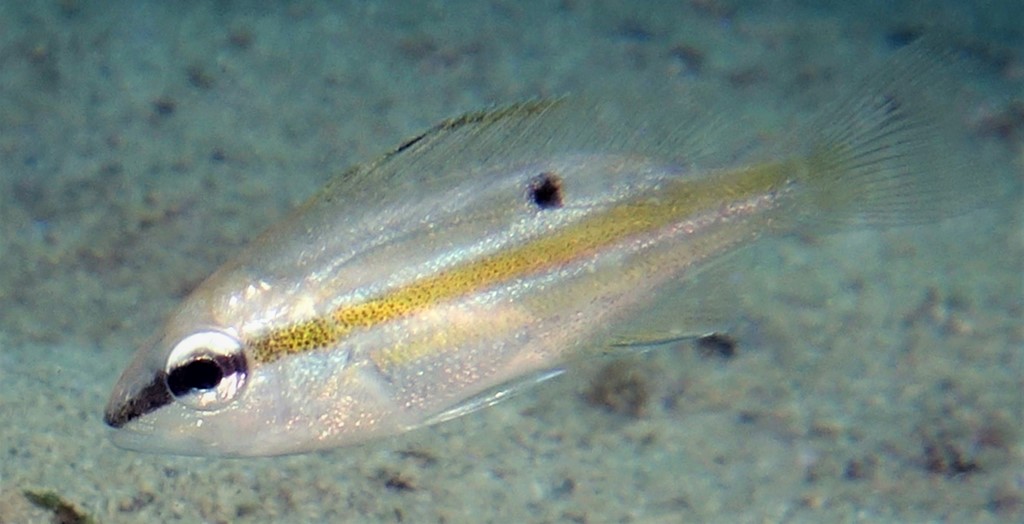LUTJANUS QUINQUELINEATUS - (BLOCH, 1790)
Picture courtesy of: Yves Thévenet
Vivaneau à cinq raies bleues, Vivaneau à cinq bandes, Perche à raies bleues, Lutjan cinq lignes, Gold-striped sea-perch, Fivelined seaperch, Fiveline snapper, Five-lined snapper, Five-lined seaperch, Five-line snapper, Five lined snapper, Blue-striped snapper, Blue-banded snapper, Blue-banded sea-perch, Femlinjet snapper, Pargo de cinco lineas, Rokusen-fuedai, Shima-Tarumi, ロクセンフエダイ, 오선점퉁돔, 五带笛鲷, 五線笛鯛, Cá Hồng năm sọc,
Synonymes
Diacope decemlineata (Valenciennes, 1830)
Diacope spilura (Bennett, 1833)
Genyoroge grammica (Day, 1871)
Genyoroge notata sexlineatus (Saville-Kent, 1893)
Genyoroge notata sublineata (De Vis, 1884)
Grammistes quinquevittatus (Bloch & Schneider, 1801)
Holocentrus quinquelinearis (Bloch, 1790)
Holocentrus quinquelineatus (Bloch, 1790)
Lutianus quinquelineatus (Bloch, 1790)
Lutianus spilurus (Bennett, 1833)
Lutjanus spilurus (Bennett, 1833)
-------------------------
Description
Dorsal spines (total): 10; Dorsal soft rays (total): 13-15; Anal spines: 3; Anal soft rays: 8; Pectoral fin rays: 16-17; Lateral line scales: 47-50; Body depth: 2.3-2.9 in SL. Dorsal profile of head steeply sloped. Preorbital width usually less than eye diameter. Preopercular notch and knob well developed. Scale rows on back rising obliquely above lateral line. Vomerine tooth patch crescentic, without a medial posterior extension; Tongue smooth, without teeth. First gill arch with 20-23 gill rakers, of which 13-15 (including rudiments) on lower limb. Posterior profile of dorsal and anal fins rounded to somewhat angular. Caudal fin truncate or slightly emarginate. Max. length: 38.0 cm TL, common length: 30.0 cm TL. Max. reported age: 31 years. Depth range: 2 - 40 m.
Color
Upper part of head brownish; Sides and belly bright yellow; A series of five bright blue stripes on sides; A round black spot, about the size of the eye or larger, is below the anterior most soft dorsal rays, touching the lateral line but mostly above it. Fins yellow.
Etymology
Lutjanus: from Malay, ikan lutjan, name of a fish.
quinquelineatus: from Latin, quinque = five and Latin, linea = line. Referring to five blue stripes on sides.
Original description: Holocentrus quinquelineatus Bloch, 1790 - Type locality: Japan.
Distribution
Indo-West Pacific: Socotra and Persian Gulf east to Philippines and Fiji, north to southern Japan, south to southern New South Wales (Australia), New Caledonia and Lord Howe Island.
Biology
Adults inhabit sheltered lagoons and exposed, outer slope coral reefs. Frequently encountered in large aggregations including 100 or more individuals. Juveniles solitary and shallow in protected bays with algae and rubble substrates. They feed mainly on fishes and crustaceans. A good eating fish commonly found in markets throughout its range, also important in artisanal fisheries. Caught mainly with handlines, traps, and gill nets.
Similar species
Lutjanus coeruleolineatus (Rüppell, 1838) - Reported from Red Sea, northwestern Indian Ocean: Gulf of Aden, Socotra, Gulf of Oman and Pakistan. Generally yellow, darker on back, grading to whitish ventrally with a series of seven or eight narrow, blue, longitudinal stripes on the sides, a large blackish spot on the lateral line below the anterior portion of the soft dorsal rays, and blue spots and broken lines on the head.
Lutjanus ehrenbergii (Peters, 1869) - Reported from Red Sea; Indo-West Pacific: East Africa, Persian Gulf, Socotra and Madagascar east to Caroline Islands and Fiji, Taiwan, north to Ryukyu Islands and Wakayama Prefecture (Japan), south to Northern Territory (Australia). Back and upper sides dark brown; Lower sides and belly whitish with a silver sheen. Often with a series of four or five narrow yellow stripes on the sides below the lateral line. A prominent round, black spot on the back below the posterior part of the spinous portion of the dorsal fin.
Lutjanus kasmira (Fabricius, 1775) - Reported from New Caledonia - Link to the species (here).
Last update: 16, April 2022
Last update: 16, April 2022
